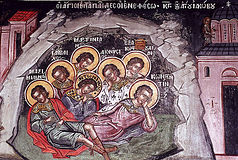

| Previous day | Next day |
| Old Style
August 4
|
Monday |
New Style
August 17
|
|
11th Week after Pentecost.
Tone 1.
Успенский пост. |
Monastic rule: xerophagy (bread, uncooked fruits and vegetables).
|
![]() The Holy Seven Youths (“Seven Sleepers”) of Ephesus: Maximilian, Jamblicus, Martinian, John, Dionysius, Exacustodian (Constantine), and Antoninus (250 and ca. 446).
The Holy Seven Youths (“Seven Sleepers”) of Ephesus: Maximilian, Jamblicus, Martinian, John, Dionysius, Exacustodian (Constantine), and Antoninus (250 and ca. 446).
Martyr Eleutherius of Byzantium (beg. of 4th c.). Martyr Eudocia of Anatolia in Persia (362-364).
New Hieromartyr Michael (Zhuk), hieromonk, of Staroye Zubarevo (Mordovia) (1937).
New Hieromartyr Cosmas of Aitolia, Equal-to-the-Apostles (1779). Martyrs Ia and 9,000 with her in Persia (363).
Thoughts for Each Day of the Year
According to the Daily Church Readings from the Word of God
By St. Theophan the Recluse

Monday. [II Cor. 2:4-15; Matt. 23:13-22]
Woe unto you…for ye shut up the Kingdom of Heaven against men. This is said to the chief priests, who neither teach the people themselves the saving path, nor compel the priests to do it; this is said also to priests who leave the people in neglect, not taking care to explain to them what is necessary for the salvation of the soul. From this the people remain in blindness, and one part remains in the certainty that it is going properly; the other, though it notices that things are not going the right way, does not go where it should, because it does not know how and where to go. This causes various silly ideas to spread among the people; this is why schismatics, molokans and khlysts[1] find acceptance among them, and this is how every evil teaching finds convenient access to them. A priest usually thinks that in his parish everything is fine, and rushes into action only when this evil has already spread and come to light. But then it is too late do anything about it. A priest must consider it the first priority of his conscience to continually instruct the adults in the knowledge of the Christian faith, and to prepare the young generation from their first conscious years, explaining to them what they can and must know. There is no need to wait for school. This must be done orally, gathering the children in the church and at home on Sunday evenings, or whenever and however it is convenient.
[1] Schismatics refer to the Old Believers, and Molokans and Klysts were Russian sects.
Articles
 7 Holy Youths “Seven Sleepers” of EphesusThe Seven Youths of Ephesus: Maximilian, Iamblicus, Martinian, John, Dionysius, Exacustodianus (Constantine) and Antoninus, lived in the third century. |


